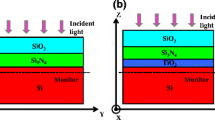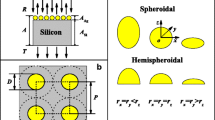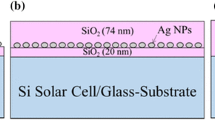Abstract
This work reports on a numerical simulation study of the front surface modification of silicon solar cells by using composite metallic nanoparticle arrays. On top of the front surface of the cells, composite arrays that are made of silver or gold nanoparticles are carefully designed. The radii of the nanoparticles in the composite array and the lattice constant of the array are respectively varied, and the corresponding light reflectance at the front surface of the cell is calculated in the wavelength range from 400 to 1100 nm, via the FDTD method. The results determined from the composite arrays reveal that the reflectance curve across the whole wavelength range studied presents a more uniform behavior, compared with simple arrays. It is shown that the surface plasmon excitation effect of the metallic nanoparticles plays a crucial role in the light reflectance performance at the front surface of the silicon solar cells. The dependence of the light reflectance on the direction of the incident light’s polarization is also investigated, and it is found that the polarization has little effect on the reflectance curves once the composite arrays are optimized.








Similar content being viewed by others
References
Chhajed S, Schubert M F, Kim J K, Schubert E F (2008) Nanostructured multilayer graded-index antireflection coating for Si solar cells with broadband and omnidirectional characteristics. Appl. Phys. Lett. 93 (25):251108
Zhao J, Wang A, Altermatt P, Green M A (1995) Twenty-four percent efficient silicon solar cells with double layer antireflection coatings and reduced resistance loss. Appl Phys Lett 66(26):3636–3638
Han K S, Shin J H, Lee H (2010) Enhanced transmittance of glass plates for solar cells using nano-imprint lithography. Sol Energy Mater Sol Cells 94(3):583–587
Liu B, Qiu S, Chen N, Du G, Sun J (2013) Double-layered silicon nitride antireflection coatings for multicrystalline silicon solar cells. Mater Sci Semicond Process 16(3):1014–1021
Lee Y J, Ruby D S, Peters D W, McKenzie B B, Hsu J W (2008) Zno nanostructures as efficient antireflection layers in solar cells. Nano Lett 8(5):1501–1505
Singh H K, Sharma P, Solanki C S (2014) Broadband reflection minimization using silver ultra thin film sandwiched between silicon nitride layers for c-Si solar cell application. Plasmonics 9(6):1409–1416
Bae H S, Kim C, Rhee I, Jo H J, Kim D H, Hong S (2014) Enhancement of the CIGS solar cells efficiency by anti-reflection coating with Teflon AF. J Korean Physical Soc 65(10):1517–1519
Garnett E, Yang P (2010) Light trapping in silicon nanowire solar cells. Nano Lett 10(3):1082–1087
Han S E, Chen G (2010) Optical absorption enhancement in silicon nanohole arrays for solar photovoltaics. Nano Lett 10(3):1012–1015
Pudasaini P R, Ayon A A (2012) Nanostructured thin film silicon solar cells efficiency improvement using gold nanoparticles. Phys Status Solidi (a) 209(8):1475–1480
Wang F, Yu H, Li J, Wong S, Sun X W, Wang X, Zheng H (2011) Design guideline of high efficiency crystalline Si thin film solar cell with nanohole array textured surface. J. Appl. Phys. 109(8):084306
Peng K Q, Wang X, Li L, Wu X L, Lee S T (2010) High-performance silicon nanohole solar cells. J Am Chem Soc 132(20):6872–6873
Yang J, You J, Chen C C, Hsu W C, Tan H R, Zhang X W, Hong Z, Yang Y (2011) Plasmonic polymer tandem solar cell. ACS Nano 5(8):6210–6217
Poh C H, Rosa L, Juodkazis S, Dastoor P (2011) FDTD Modeling to enhance the performance of an organic solar cell embedded with gold nanoparticles. Opt Mater Express 1(7):1326–1331
Atwater H A, Polman A (2010) Plasmonics for improved photovoltaic devices. Nat Mater 9(3):205–213
Catchpole K R, Polman A (2008) Plasmonic solar cells. Opt Express 16(26):21793–21800
Pillai S, Catchpole K R, Trupke T, Green M A (2007) Surface plasmon enhanced silicon solar cells. J. Appl. Phys. 101(9): 093105
Pudasaini P R, Ayon A A (2013) Modeling the front side plasmonics effect in nanotextured silicon surface for thin film solar cells application. Microsyst Technol 19(6):871–877
Sun C, Su J, Wang X (2015) A design of thin film silicon solar cells based on silver nanoparticle arrays. Plasmonics 10(3):633–641
Sun C, Wang X (2015) Efficient light trapping structures of thin film silicon solar cells based on silver nanoparticle arrays. Plasmonics 10(6):1307–1314
Sun C, Wang Z, Wang X, Liu J (2015) A surface design for enhancement of light trapping efficiencies in thin film silicon solar cells. Plasmonics, 1–8
Starowicz Z, Kulesza-Matlak G, Lipiski M (2015) Optimization studies on enhanced absorption in thin silicon solar cell by plasmonic silver nanoparticles for the front side configuration. Plasmonics 10(6):1639–1647
Lumerical Solutions, Inc., http://www.lumerical.com/tcad-products/fdtd/
Palik ED (1998) Handbook of optical constants of solids, Vol. 3, Academic press
Acknowledgments
C. Sun acknowledges support by Grant Number 31400718 from the National Natural Science Foundation of China.
Author information
Authors and Affiliations
Corresponding authors
Rights and permissions
About this article
Cite this article
Wang, Z., Sun, C. & Wang, X. Modification of Front Surface Antireflection of Silicon Solar Cells with Composite Metallic Nanoparticle Arrays. Plasmonics 12, 589–596 (2017). https://doi.org/10.1007/s11468-016-0302-6
Received:
Accepted:
Published:
Issue Date:
DOI: https://doi.org/10.1007/s11468-016-0302-6




